54b MITSUBISHI LANCER 2005 Workshop Manual
[x] Cancel search | Manufacturer: MITSUBISHI, Model Year: 2005, Model line: LANCER, Model: MITSUBISHI LANCER 2005Pages: 788, PDF Size: 45.98 MB
Page 304 of 788
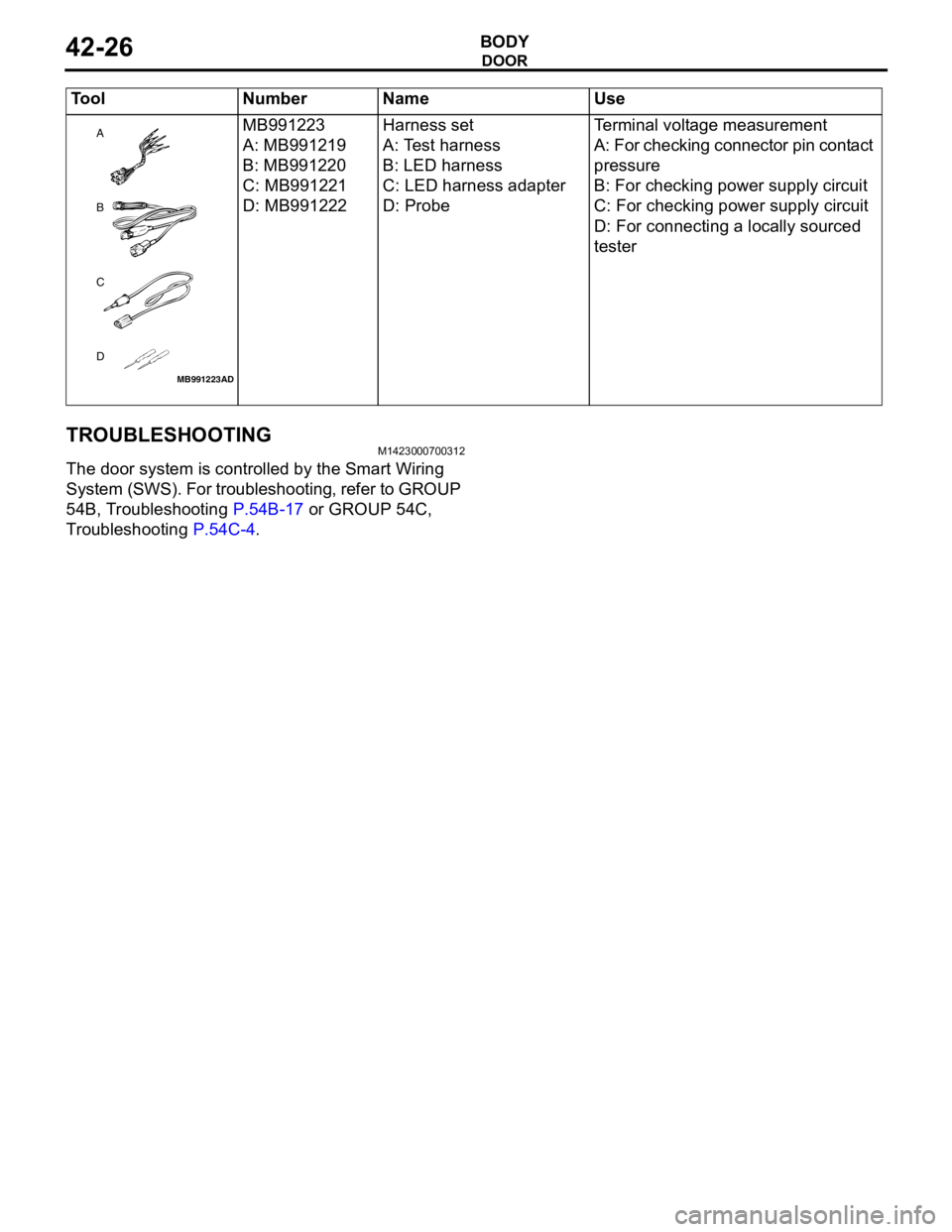
DOOR
BODY42-26
TROUBLESHOOTINGM1423000700312
The door system is controlled by the Smart Wiring
System (SWS). For troubleshooting, refer to GROUP
54B, Troubleshooting P.54B-17 or GROUP 54C,
Troubleshooting P.54C-4. MB991223
A: MB991219
B: MB991220
C: MB991221
D: MB991222Harness set
A: Test harness
B: LED harness
C: LED harness adapter
D: ProbeTerminal voltage measurement
A: For checking connector pin contact
pressure
B: For checking power supply circuit
C: For checking power supply circuit
D: For connecting a locally sourced
tester Tool Number Name Use
MB991223
A
D C
B
AD
Page 307 of 788
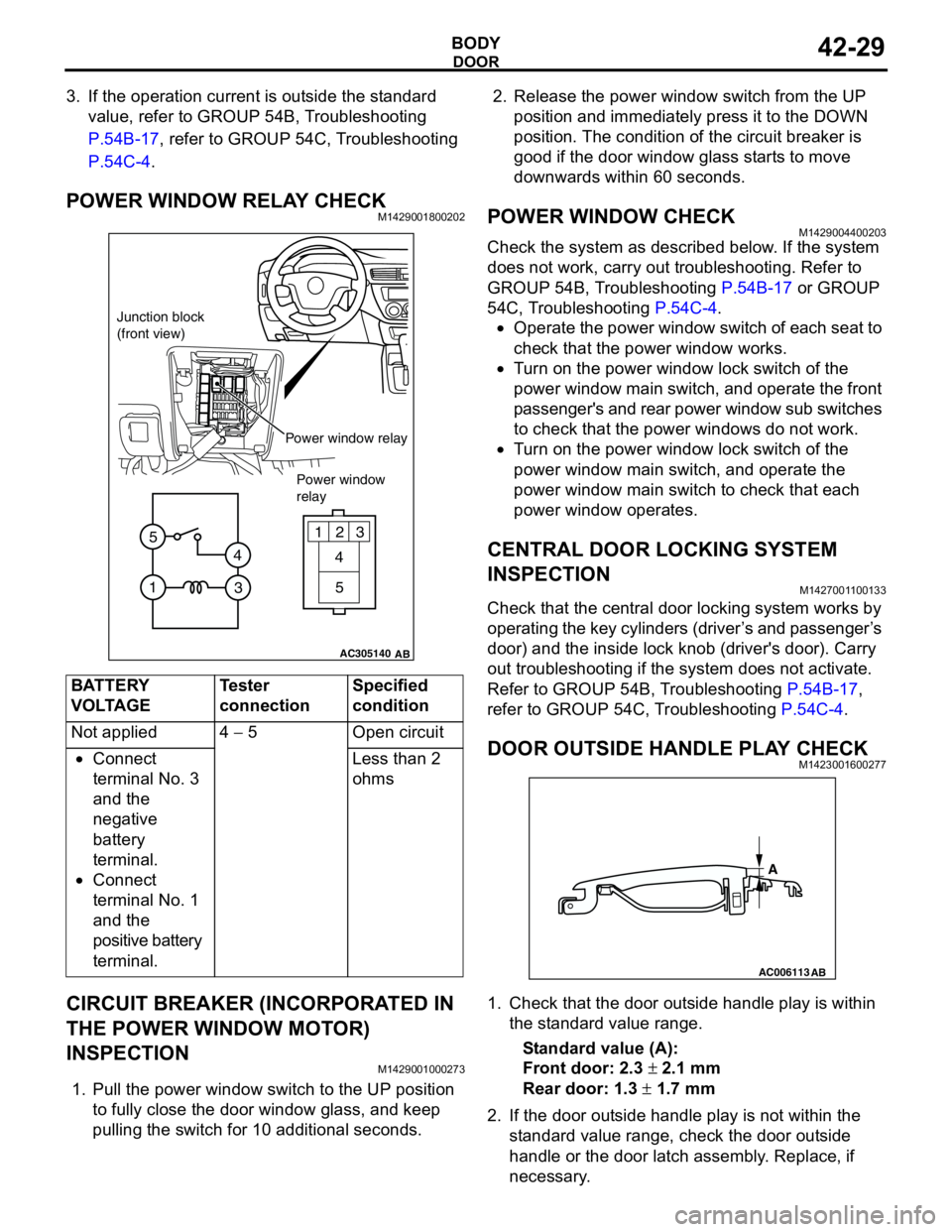
DOOR
BODY42-29
3. If the operation current is outside the standard
value, refer to GROUP 54B, Troubleshooting
P.54B-17, refer to GROUP 54C, Troubleshooting
P.54C-4.
POWER WINDOW RELAY CHECKM1429001800202
CIRCUIT BREAKER (INCORPORATED IN
THE POWER WINDOW MOTOR)
INSPECTION
M1429001000273
1. Pull the power window switch to the UP position
to fully close the door window glass, and keep
pulling the switch for 10 additional seconds.2. Release the power window switch from the UP
position and immediately press it to the DOWN
position. The condition of the circuit breaker is
good if the door window glass starts to move
downwards within 60 seconds.
POWER WINDOW CHECKM1429004400203
Check the system as described below. If the system
does not work, carry out troubleshooting. Refer to
GROUP 54B, Troubleshooting P.54B-17 or GROUP
54C, Troubleshooting P.54C-4.
•Operate the power window switch of each seat to
check that the power window works.
•Turn on the power window lock switch of the
power window main switch, and operate the front
passenger's and rear power window sub switches
to check that the power windows do not work.
•Turn on the power window lock switch of the
power window main switch, and operate the
power window main switch to check that each
power window operates.
CENTRAL DOOR LOCKING SYSTEM
INSPECTION
M1427001100133
Check that the central door locking system works by
operating the key cylinders (driver’s and passenger’s
door) and the inside lock knob (driver's door). Carry
out troubleshooting if the system does not activate.
Refer to GROUP 54B, Troubleshooting P.54B-17,
refer to GROUP 54C, Troubleshooting P.54C-4.
DOOR OUTSIDE HANDLE PLAY CHECKM1423001600277
1. Check that the door outside handle play is within
the standard value range.
Standard value (A):
Front door: 2.3 ± 2.1 mm
Rear door: 1.3 ± 1.7 mm
2. If the door outside handle play is not within the
standard value range, check the door outside
handle or the door latch assembly. Replace, if
necessary. BATTERY
VOLTAGETester
connectionSpecified
condition
Not applied 4 − 5 Open circuit
•Connect
terminal No. 3
and the
negative
battery
terminal.
•Connect
terminal No. 1
and the
positive battery
terminal.Less than 2
ohms
AC305140
123
4
5
1
3 4 5
AB
Junction block
(front view)
Power window relay
Power window
relay
AC006113
AB
A
Page 324 of 788
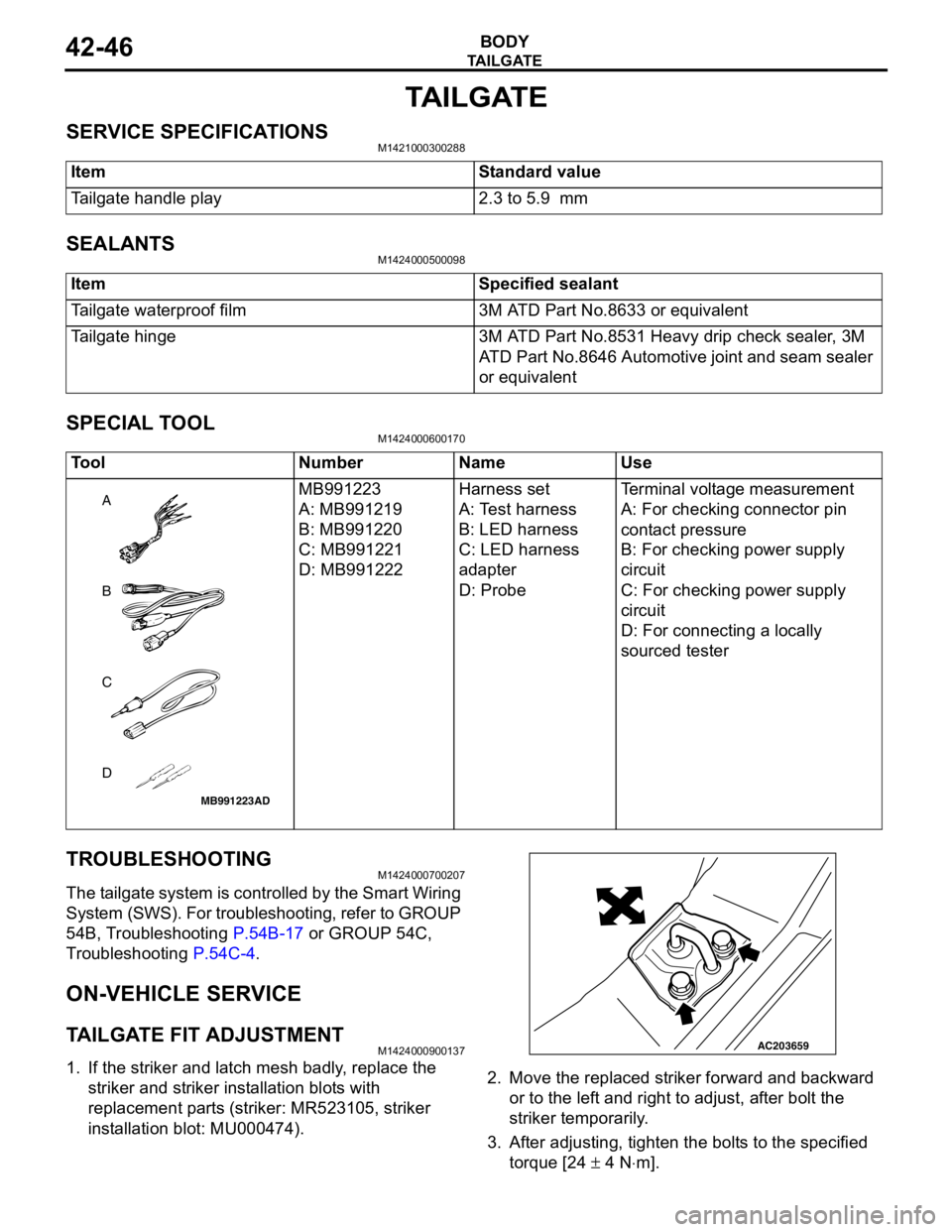
TA I L G AT E
BODY42-46
TA I L G AT E
SERVICE SPECIFICATIONSM1421000300288
SEALANTSM1424000500098
SPECIAL TOOLM1424000600170
TROUBLESHOOTINGM1424000700207
The tailgate system is controlled by the Smart Wiring
System (SWS). For troubleshooting, refer to GROUP
54B, Troubleshooting P.54B-17 or GROUP 54C,
Troubleshooting P.54C-4.
ON-VEHICLE SERVICE
TAILGATE FIT ADJUSTMENTM1424000900137
1. If the striker and latch mesh badly, replace the
striker and striker installation blots with
replacement parts (striker: MR523105, striker
installation blot: MU000474).2. Move the replaced striker forward and backward
or to the left and right to adjust, after bolt the
striker temporarily.
3. After adjusting, tighten the bolts to the specified
torque [24 ± 4 N⋅m]. Item Standard value
Tailgate handle play 2.3 to 5.9 mm
Item Specified sealant
Tailgate waterproof film 3M ATD Part No.8633 or equivalent
Tailgate hinge 3M ATD Part No.8531 Heavy drip check sealer, 3M
ATD Part No.8646 Automotive joint and seam sealer
or equivalent
Tool Number Name Use
MB991223
A: MB991219
B: MB991220
C: MB991221
D: MB991222Harness set
A: Test harness
B: LED harness
C: LED harness
adapter
D: ProbeTerminal voltage measurement
A: For checking connector pin
contact pressure
B: For checking power supply
circuit
C: For checking power supply
circuit
D: For connecting a locally
sourced tester
MB991223
A
D C
B
AD
AC203659
Page 331 of 788
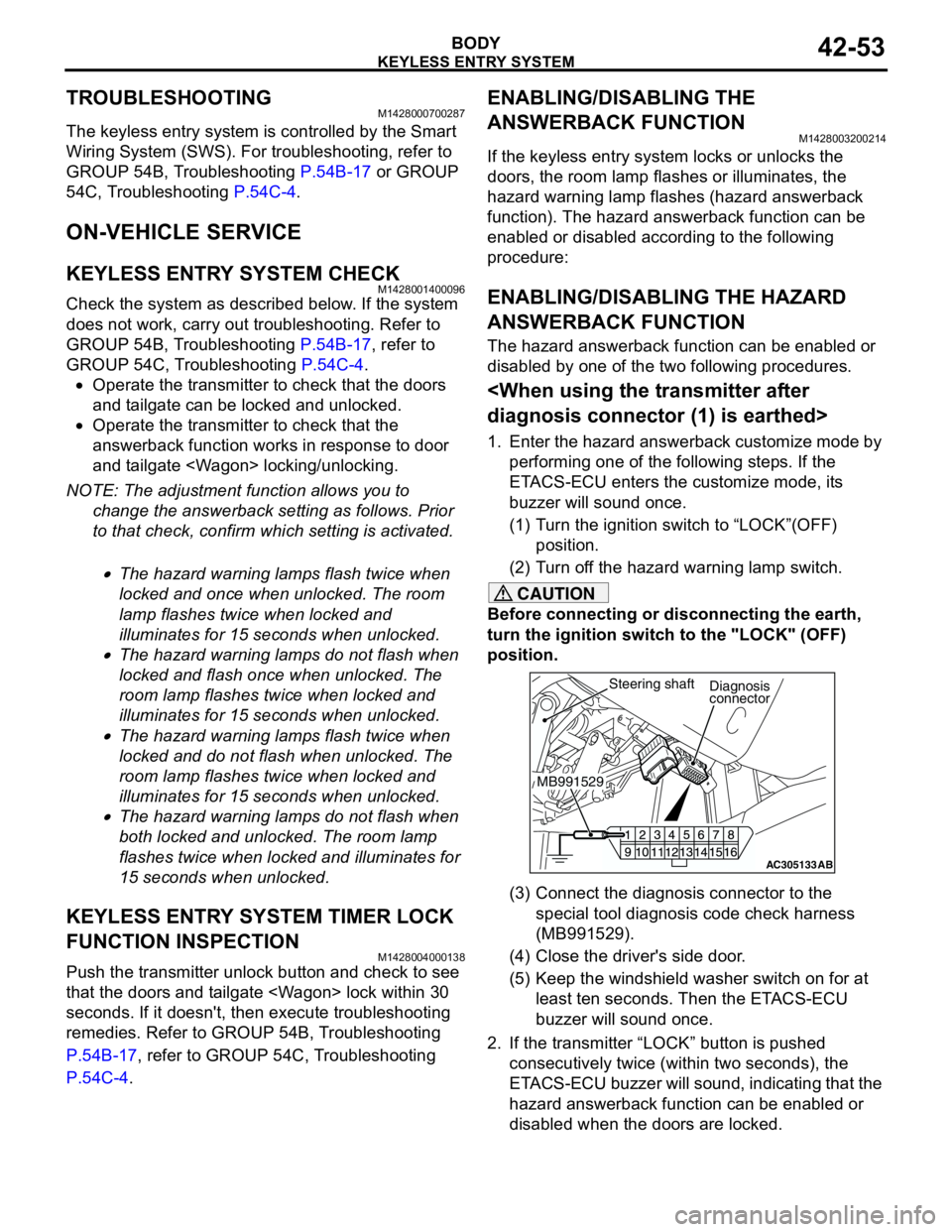
KEYLESS ENTRY SYSTEM
BODY42-53
TROUBLESHOOTINGM1428000700287
The keyless entry system is controlled by the Smart
Wiring System (SWS). For troubleshooting, refer to
GROUP 54B, Troubleshooting P.54B-17 or GROUP
54C, Troubleshooting P.54C-4.
ON-VEHICLE SERVICE
KEYLESS ENTRY SYSTEM CHECKM1428001400096
Check the system as described below. If the system
does not work, carry out troubleshooting. Refer to
GROUP 54B, Troubleshooting P.54B-17, refer to
GROUP 54C, Troubleshooting P.54C-4.
•Operate the transmitter to check that the doors
and tailgate can be locked and unlocked.
•Operate the transmitter to check that the
answerback function works in response to door
and tailgate
NOTE: The adjustment function allows you to
change the answerback setting as follows. Prior
to that check, confirm which setting is activated.
.
•The hazard warning lamps flash twice when
locked and once when unlocked. The room
lamp flashes twice when locked and
illuminates for 15 seconds when unlocked.
•The hazard warning lamps do not flash when
locked and flash once when unlocked. The
room lamp flashes twice when locked and
illuminates for 15 seconds when unlocked.
•The hazard warning lamps flash twice when
locked and do not flash when unlocked. The
room lamp flashes twice when locked and
illuminates for 15 seconds when unlocked.
•The hazard warning lamps do not flash when
both locked and unlocked. The room lamp
flashes twice when locked and illuminates for
15 seconds when unlocked.
KEYLESS ENTRY SYSTEM TIMER LOCK
FUNCTION INSPECTION
M1428004000138
Push the transmitter unlock button and check to see
that the doors and tailgate
seconds. If it doesn't, then execute troubleshooting
remedies. Refer to GROUP 54B, Troubleshooting
P.54B-17, refer to GROUP 54C, Troubleshooting
P.54C-4.
ENABLING/DISABLING THE
ANSWERBACK FUNCTION
M1428003200214
If the keyless entry system locks or unlocks the
doors, the room lamp flashes or illuminates, the
hazard warning lamp flashes (hazard answerback
function). The hazard answerback function can be
enabled or disabled according to the following
procedure:
ENABLING/DISABLING THE HAZARD
ANSWERBACK FUNCTION
The hazard answerback function can be enabled or
disabled by one of the two following procedures.
1. Enter the hazard answerback customize mode by
performing one of the following steps. If the
ETACS-ECU enters the customize mode, its
buzzer will sound once.
(1) Turn the ignition switch to “LOCK”(OFF)
position.
(2) Turn off the hazard warning lamp switch.
CAUTION
Before connecting or disconnecting the earth,
turn the ignition switch to the "LOCK" (OFF)
position.
(3) Connect the diagnosis connector to the
special tool diagnosis code check harness
(MB991529).
(4) Close the driver's side door.
(5) Keep the windshield washer switch on for at
least ten seconds. Then the ETACS-ECU
buzzer will sound once.
2. If the transmitter “LOCK” button is pushed
consecutively twice (within two seconds), the
ETACS-ECU buzzer will sound, indicating that the
hazard answerback function can be enabled or
disabled when the doors are locked.
AC305133AB
Diagnosis
connector
MB991529Steering shaft
Page 360 of 788

WINDSHIELD WIPER AND WASHER
EXTERIOR51-22
SERVICE SPECIFICATIONM1511000300325
TROUBLESHOOTINGM1511000700323
The windshield wiper and washer are controlled by
the Smart Wiring System (SWS). For
troubleshooting, refer to GROUP 54B,
Troubleshooting P.54B-17 or GROUP 54C,
Troubleshooting P.54C-4.
NOTE: Even when the ETACS-ECU has failed, the
windshield wiper can work at low speed as fail-safe
mode. (Normally, the windshield wiper operates
when the ignition switch is at the "ACC" position. But,
if it enters the fail-safe mode, the wiper can operate
only when the ignition switch is at the "ON" position.)
ON-VEHICLE SERVICEM1511000800461
WINDSHIELD INTERMITTENT WIPER
INSPECTION
1. If the windshield intermittent wiper interval
adjusting knob is operated, the wiper interval
should change.
2. Holding the windshield intermittent wiper interval
adjusting knob, input the simulated vehicle speed
with MUT-II MB991502 and check that the wiper
interval changes as the vehicle speed changes.
3. If not, carry out the troubleshooting (Refer to
GROUP 54B, Troubleshooting P.54B-17 or
GROUP 54C, Troubleshooting P.54C-4). ItemStandard value
Windshield wiper blade park position mm 34 ± 5
Page 366 of 788

REAR WIPER AND WASHER
EXTERIOR51-28
REAR WIPER AND WASHER
GENERAL INFORMATIONM1511000100525
REAR WIPER AND WASHER OPERATION
Rear Wiper Operation
•If the rear wiper and washer switch is turned to
"INT" position with the ignition switch at "ACC" or
"ON" position, the ETACS-ECU turns ON the rear
wiper drive signal for three seconds
(approximately two cycles), then 7.4 seconds
later the intermittent motion operates every eight
seconds. If the selector lever is moved to the "R"
position when the rear wiper and washer switch is
turned to the "INT" position and the ignition
switch is at the "ACC" or "ON" position, the inhibitor switch "R" turns ON. One second later,
the ETACS-ECU turns ON the rear wiper drive
signal for three seconds (approximately two
cycles). Then, 7.4 seconds later, the intermittent
motion of eight seconds' cycle is restored.
Rear Washer Operation
•If the rear wiper and washer switch is turned to
the ON (washer) position with the ignition switch
at the "ACC" or "ON" position, the rear washer
ON signal is sent to the ETACS-ECU, causing the
rear wiper signal to turn on after 0.3 second. After
the rear washer switch signal turns off, the rear
wiper signal turns off in three seconds. If the rear
washer switch is turned to the ON position while
the rear wiper is in intermittent mode, the rear
washer works for that period when the washer
switch remains on. Then the rear wipers return to
the intermittent mode.
SERVICE SPECIFICATIONM1511000300336
TROUBLESHOOTINGM1511000700334
The rear wiper and washer are controlled by the
Smart Wiring System (SWS). For troubleshooting,
refer to GROUP 54B, Troubleshooting P.54B-17 or
GROUP 54C, Troubleshooting P.54C-4.
ON-VEHICLE SERVICEM1511000800472
CHECK OF REAR WIPER OPERATION
WHEN SELECTOR LEVER IS AT THE "R"
POSITION
1. When the selector lever is moved to the "R"
position with the rear wiper switch at the "INT"
position, the wiper should operate twice or three
times at low speed after approximately one
second.
2. If not, carry out the troubleshooting (Refer to
GROUP 54B, Troubleshooting P.54B-17 or
GROUP 54C, Troubleshooting P.54C-4). ItemStandard value
Rear wiper blade park position mm 42 ± 5
Page 370 of 788
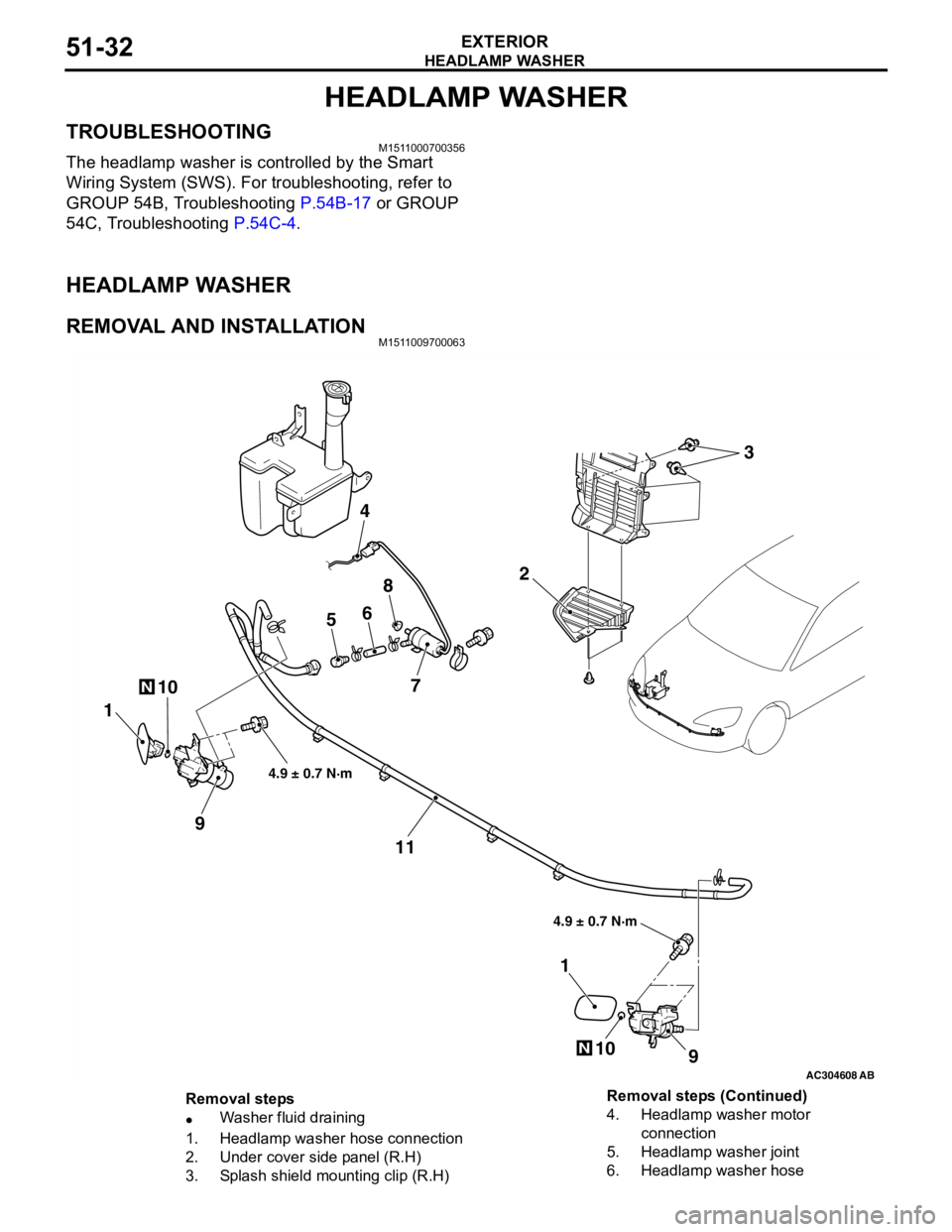
HEADLAMP WASHER
EXTERIOR51-32
HEADLAMP WASHER
TROUBLESHOOTINGM1511000700356
The headlamp washer is controlled by the Smart
Wiring System (SWS). For troubleshooting, refer to
GROUP 54B, Troubleshooting P.54B-17 or GROUP
54C, Troubleshooting P.54C-4.
HEADLAMP WASHER
REMOVAL AND INSTALLATIONM1511009700063
AC304608AB
10N
2
4
56
8
7
1
9
11
9
1
10N
4.9 ± 0.7 N·m 4.9 ± 0.7 N·m
3
Removal steps
•Washer fluid draining
1. Headlamp washer hose connection
2. Under cover side panel (R.H)
3. Splash shield mounting clip (R.H)4. Headlamp washer motor
connection
5. Headlamp washer joint
6. Headlamp washer hose Removal steps (Continued)
Page 397 of 788
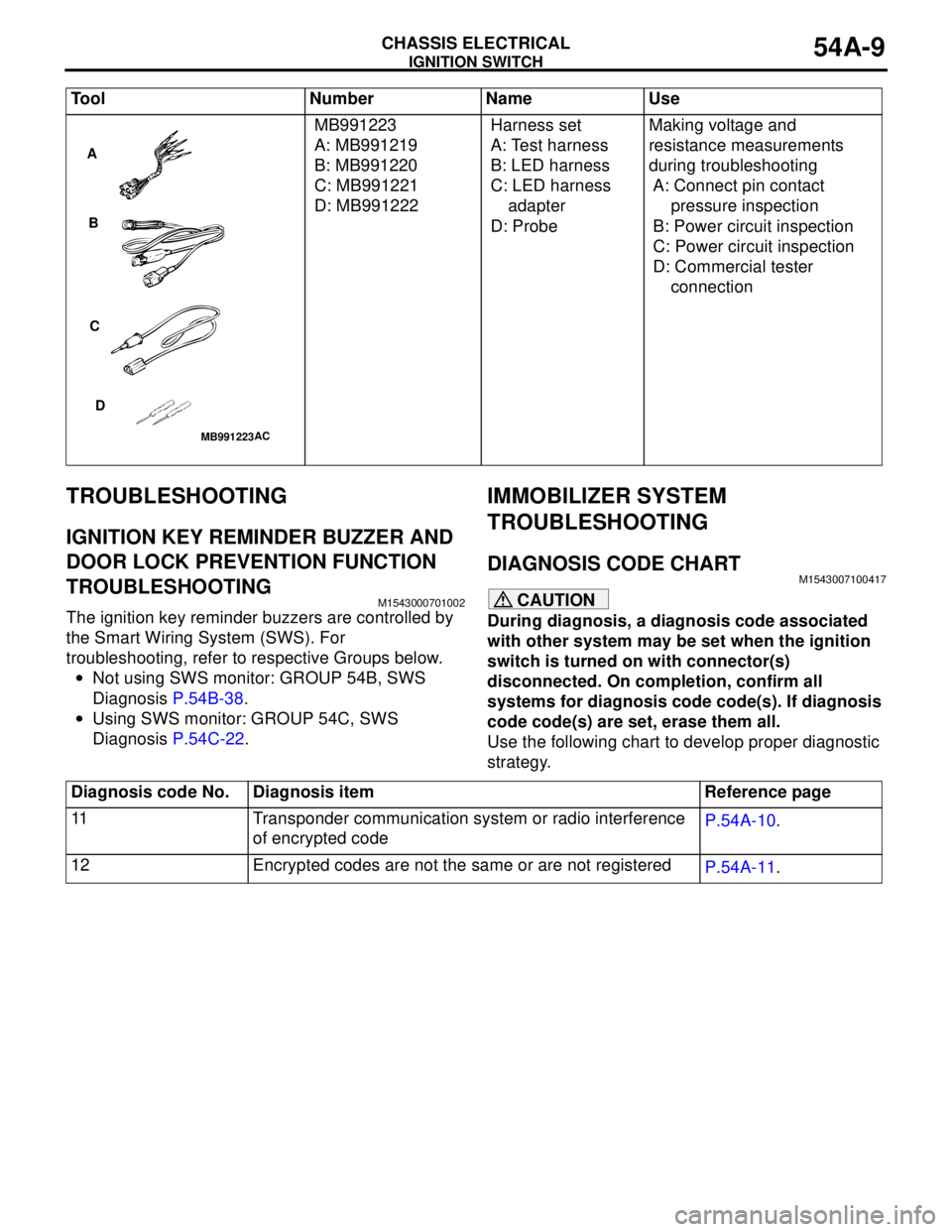
IGNITION SWITCH
CHASSIS ELECTRICAL54A-9
TROUBLESHOOTING
IGNITION KEY REMINDER BUZZER AND
DOOR LOCK PREVENTION FUNCTION
TROUBLESHOOTING
M1543000701002
The ignition key reminder buzzers are controlled by
the Smart Wiring System (SWS). For
troubleshooting, refer to respective Groups below.
•Not using SWS monitor: GROUP 54B, SWS
Diagnosis P.54B-38.
•Using SWS monitor: GROUP 54C, SWS
Diagnosis P.54C-22.
IMMOBILIZER SYSTEM
TROUBLESHOOTING
DIAGNOSIS CODE CHARTM1543007100417
CAUTION
During diagnosis, a diagnosis code associated
with other system may be set when the ignition
switch is turned on with connector(s)
disconnected. On completion, confirm all
systems for diagnosis code code(s). If diagnosis
code code(s) are set, erase them all.
Use the following chart to develop proper diagnostic
strategy. MB991223
A: MB991219
B: MB991220
C: MB991221
D: MB991222Harness set
A: Test harness
B: LED harness
C: LED harness
adapter
D: ProbeMaking voltage and
resistance measurements
during troubleshooting
A: Connect pin contact
pressure inspection
B: Power circuit inspection
C: Power circuit inspection
D: Commercial tester
connection Tool Number Name Use
MB991223
A
B
C
D
AC
Diagnosis code No. Diagnosis item Reference page
11 Transponder communication system or radio interference
of encrypted codeP.54A-10.
12 Encrypted codes are not the same or are not registered
P.54A-11.
Page 454 of 788
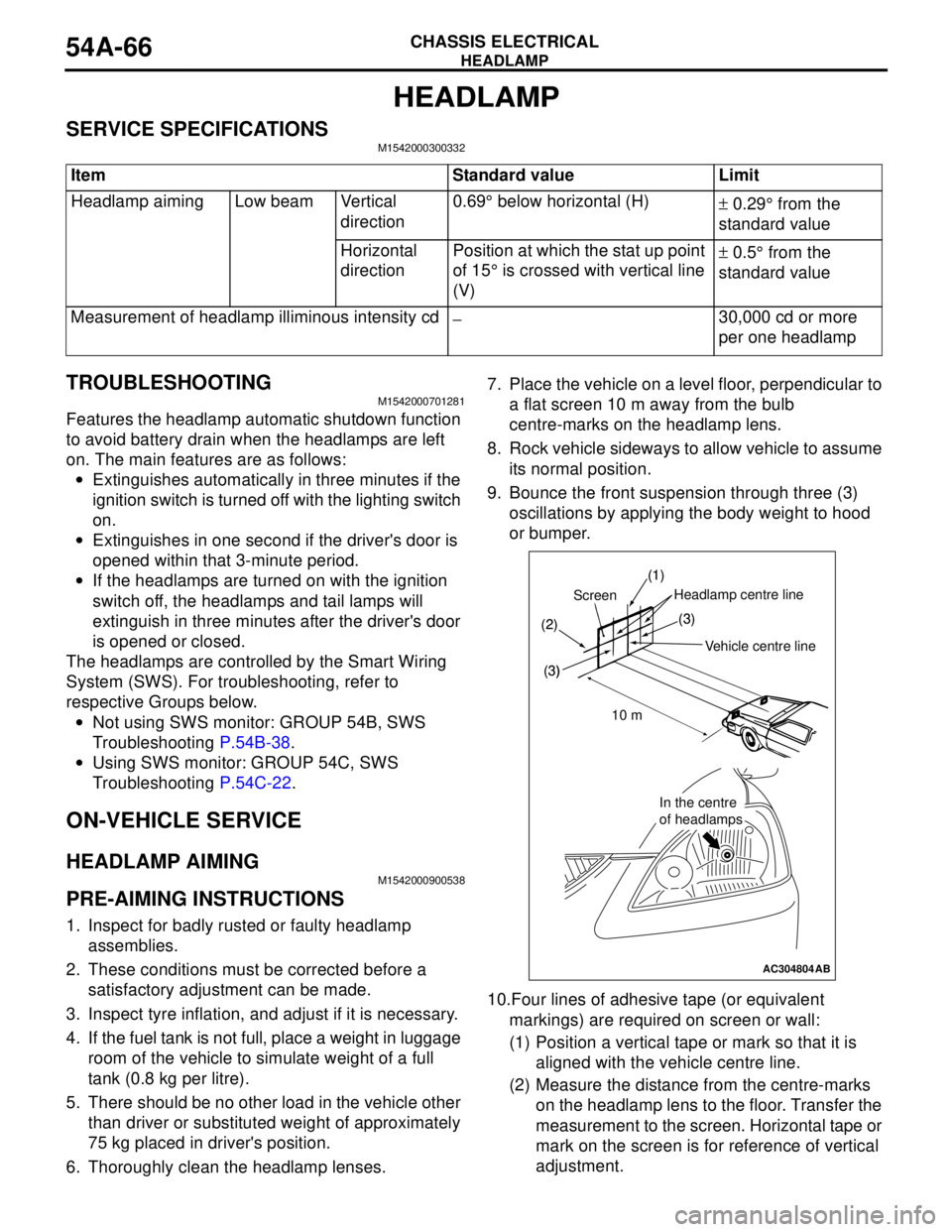
HEADLAMP
CHASSIS ELECTRICAL54A-66
HEADLAMP
SERVICE SPECIFICATIONSM1542000300332
TROUBLESHOOTING M1542000701281
Features the headlamp automatic shutdown function
to avoid battery drain when the headlamps are left
on. The main features are as follows:
•Extinguishes automatically in three minutes if the
ignition switch is turned off with the lighting switch
on.
•Extinguishes in one second if the driver's door is
opened within that 3-minute period.
•If the headlamps are turned on with the ignition
switch off, the headlamps and tail lamps will
extinguish in three minutes after the driver's door
is opened or closed.
The headlamps are controlled by the Smart Wiring
System (SWS). For troubleshooting, refer to
respective Groups below.
•Not using SWS monitor: GROUP 54B, SWS
Troubleshooting P.54B-38.
•Using SWS monitor: GROUP 54C, SWS
Troubleshooting P.54C-22.
ON-VEHICLE SERVICE
HEADLAMP AIMING
M1542000900538
PRE-AIMING INSTRUCTIONS
1. Inspect for badly rusted or faulty headlamp
assemblies.
2. These conditions must be corrected before a
satisfactory adjustment can be made.
3. Inspect tyre inflation, and adjust if it is necessary.
4. If the fuel tank is not full, place a weight in luggage
room of the vehicle to simulate weight of a full
tank (0.8 kg per litre).
5. There should be no other load in the vehicle other
than driver or substituted weight of approximately
75 kg placed in driver's position.
6. Thoroughly clean the headlamp lenses.7. Place the vehicle on a level floor, perpendicular to
a flat screen 10 m away from the bulb
centre-marks on the headlamp lens.
8. Rock vehicle sideways to allow vehicle to assume
its normal position.
9. Bounce the front suspension through three (3)
oscillations by applying the body weight to hood
or bumper.
10.Four lines of adhesive tape (or equivalent
markings) are required on screen or wall:
(1) Position a vertical tape or mark so that it is
aligned with the vehicle centre line.
(2) Measure the distance from the centre-marks
on the headlamp lens to the floor. Transfer the
measurement to the screen. Horizontal tape or
mark on the screen is for reference of vertical
adjustment. Item Standard value Limit
Headlamp aiming Low beam Vertical
direction0.69° below horizontal (H)
± 0.29° from the
standard value
Horizontal
directionPosition at which the stat up point
of 15° is crossed with vertical line
(V)± 0.5° from the
standard value
Measurement of headlamp illiminous intensity cd
−30,000 cd or more
per one headlamp
AC304804
(1)
(2)
(3)
Headlamp centre line
Vehicle crntre line Screen
(3)
10 m
In the centre
of headlamps
(1)
(2)
(3)(3)
In the centre
of headlamps
AB
Vehicle centre line
ScreenHeadlamp centre line
10 m
Page 459 of 788
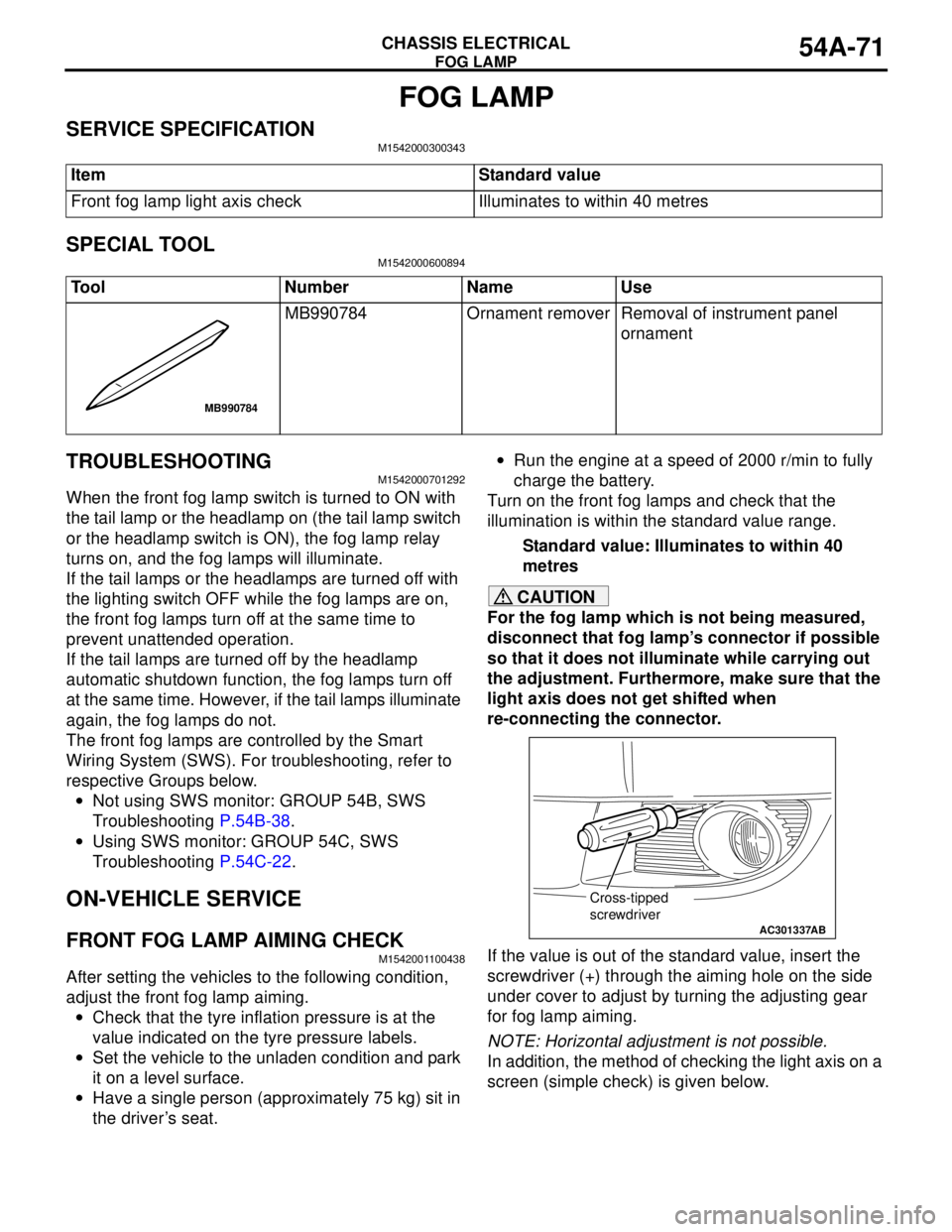
FOG LAMP
CHASSIS ELECTRICAL54A-71
FOG LAMP
SERVICE SPECIFICATIONM1542000300343
SPECIAL TOOLM1542000600894
TROUBLESHOOTINGM1542000701292
When the front fog lamp switch is turned to ON with
the tail lamp or the headlamp on (the tail lamp switch
or the headlamp switch is ON), the fog lamp relay
turns on, and the fog lamps will illuminate.
If the tail lamps or the headlamps are turned off with
the lighting switch OFF while the fog lamps are on,
the front fog lamps turn off at the same time to
prevent unattended operation.
If the tail lamps are turned off by the headlamp
automatic shutdown function, the fog lamps turn off
at the same time. However, if the tail lamps illuminate
again, the fog lamps do not.
The front fog lamps are controlled by the Smart
Wiring System (SWS). For troubleshooting, refer to
respective Groups below.
•Not using SWS monitor: GROUP 54B, SWS
Troubleshooting P.54B-38.
•Using SWS monitor: GROUP 54C, SWS
Troubleshooting P.54C-22.
ON-VEHICLE SERVICE
FRONT FOG LAMP AIMING CHECKM1542001100438
After setting the vehicles to the following condition,
adjust the front fog lamp aiming.
•Check that the tyre inflation pressure is at the
value indicated on the tyre pressure labels.
•Set the vehicle to the unladen condition and park
it on a level surface.
•Have a single person (approximately 75 kg) sit in
the driver’s seat.•Run the engine at a speed of 2000 r/min to fully
charge the battery.
Turn on the front fog lamps and check that the
illumination is within the standard value range.
Standard value: Illuminates to within 40
metres
CAUTION
For the fog lamp which is not being measured,
disconnect that fog lamp’s connector if possible
so that it does not illuminate while carrying out
the adjustment. Furthermore, make sure that the
light axis does not get shifted when
re-connecting the connector.
If the value is out of the standard value, insert the
screwdriver (+) through the aiming hole on the side
under cover to adjust by turning the adjusting gear
for fog lamp aiming.
NOTE: Horizontal adjustment is not possible.
In addition, the method of checking the light axis on a
screen (simple check) is given below. Item Standard value
Front fog lamp light axis check Illuminates to within 40 metres
Tool Number Name Use
MB990784 Ornament remover Removal of instrument panel
ornament
MB990784
AC301337
Cross-tipped
screwdriver
AB